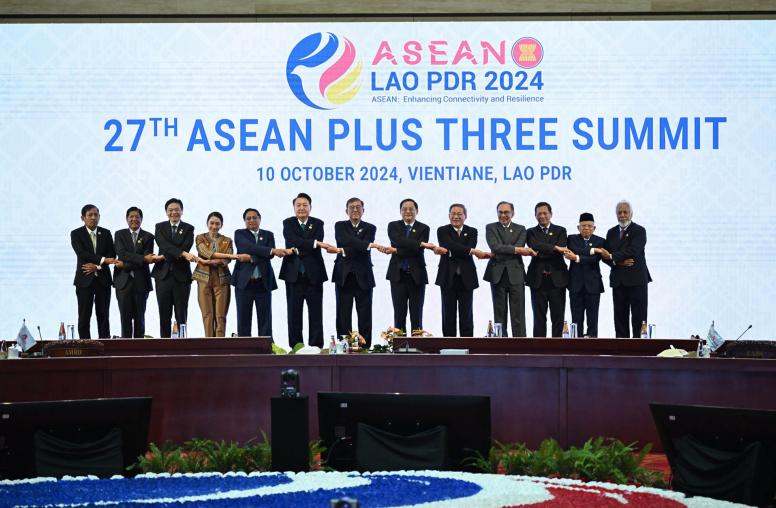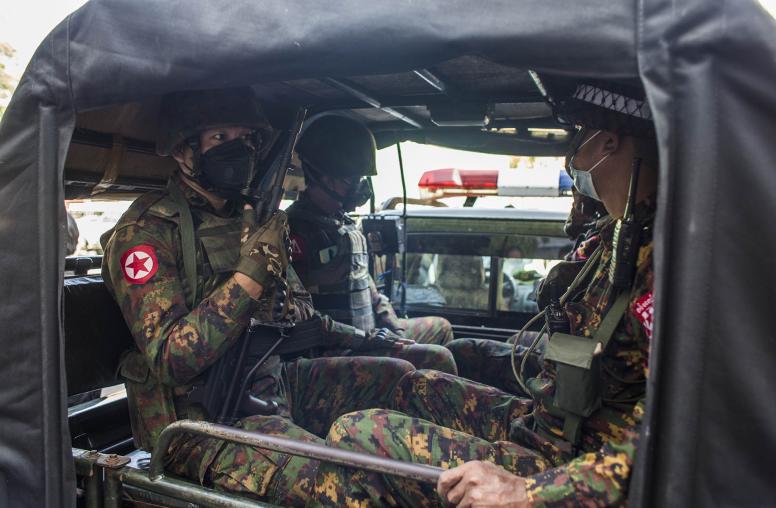Myanmar’s Ongoing War Against Women
The country is at high risk for worsening sexual violence. How can the international community respond?
When the United Nations began its annual campaign to end violence against women 30 years ago, no one had Myanmar on their radar. But in recent years, Myanmar’s military has escalated its use of sexual and gender-based violence to terrorize women and girls — most infamously against ethnic minorities, notably the Rohingya. Confronted by these atrocities, the international community has issued widespread demands for accountability and justice that have yet to come to fruition.

With reports of sexual and gender-based violence again piling up in the wake of last February’s military coup, this year’s Global 16 Days Campaign against gender-based violence should pay particular attention to Myanmar — and the United States is in the perfect position to lead the way.
Targeting Women Who Resist
Since Myanmar’s military seized control in a coup last February, women have emerged as symbols of defiance and as key leaders of resistance efforts. Generation Z women in particular have assumed prominent roles on the front lines of the civil disobedience movement. However, this has also put them at great risk. Since the coup, the junta has arrested more than a thousand women, many of whom have been held in interrogation camps in unknown locations and subjected to severe abuse.
Within months of the coup, evidence of this abuse began to pour in, as more and more women reported experiences of sexual assault at the hands of the military. Khin Lay, director of the Triangle Women Organization in Myanmar, says that women are most vulnerable when held alone during interrogation, enabling the police and military to act without witnesses.
Women experience severe verbal harassment for something as seemingly insignificant as having a tattoo. In one case from Mandalay, the police arrested a young lesbian woman; upon discovering her sexual identity, they mocked and verbally harassed her before proceeding to brutally beat her, breaking her arms and legs. Sadly, many other women have shared similar experiences as the junta inflicts sexual and gender-based violence across the country: “Women are being tortured,” said Khin Lay.
A Long, Devastating History
Sexual and gender-based violence has a long and brutal history in Myanmar, dating back to the British colonial occupation. Over a hundred years later, this violence has festered into an institutional practice for Myanmar’s military, which has committed widespread and systematic abuses against women for decades. In an analysis of hundreds of sexual and gender-based violence cases from 1998 to 2015, 85 percent of victims identified the perpetrator as someone in uniform. As one soldier put it while threatening a victim in 2012: “We have the authority to rape women.”
This pervasive, institutional violence garnered international attention in 2017, when the military used widespread and systemic sexual violence in the service of ethnic cleansing against the Rohingya in Rakhine State. Despite extensive documentation, widespread outcry among the international community and an on-going case at the International Court of Justice, the military has yet to face any consequence. Rather, it continues to employ sexual violence with impunity.
Gender and sexual minorities face additional insecurities underlined by their historical marginalization. The “Darkness Law,” another colonial legacy, allows the police to detain anyone viewed as suspicious. Functionally, it is a legal mechanism that facilitates police brutality against transgender women. Prior to the coup, police routinely arrested transgender women, who reported pervasive physical and sexually assault while in custody. Transwomen reported that “If people complain to the police when they do these things to us, they do nothing... The police think transgender and gay people are useless; that it’s better if they are dead.”
Complicated Prospects for Justice
Post-coup conflict dynamics have complicated efforts to document sexual and gender-based violence, further inhibiting prospects for justice and accountability. As Khin Lay shared, “A woman was killed, and her body was thrown into the river, it is difficult to identify who killed her … because the situation is very chaotic.”
Meanwhile, survivors rarely have the opportunity to share their stories. They typically avoid contacting friends and family or may relocate entirely for fear of their safety. Those who do come forward have limited resources to access and few prospects for accountability. While civil society organizations can provide counseling and relocation services, they lack the resources to support all victims.
The increasingly common experience of losing a friend or family member without accountability or justice leaves communities traumatized and emotionally volatile during a time when emerging local militias and People’s Defense Forces call for vengeance.
Signs of What’s to Come
The future of the conflict appears grim. Scholarship on sexual and gender-based violence suggests that armed groups will often use sexual violence as a tactic to build group loyalty during periods of high defections and prolonged exposure to traumatic violence, much like the Myanmar’s military has experienced over the past few months, in which over 2,000 soldiers have defected, and military leadership has even detained its own soldiers in an effort to curb defectors.
The military has also recently suffered some of its heaviest losses to date, with over 1,300 soldiers killed in October alone. Anecdotal accounts suggest that the military is now recruiting child soldiers, a sign that indicates an increased likelihood of sexual violence. These conditions — including high rates of defection, recruitment of child soldiers, torturing of detainees — signal that Myanmar is at a high risk for worsening conflict-related sexual violence.
At the same time, the parallel National Unity Government (NUG) has tried to respond with documentation efforts and civil society consultations, as well as recently appointing Aung Myo Min as Myanmar’s first openly gay minister to head the human rights branch of the government. But despite these efforts, the NUG struggles with internal coordination and inadequate resources. Even prior to the coup, civil society and humanitarian organizations struggled to fully report cases of sexual and gender-based violence for fear of denied access to victims. Further, reporting could incur retribution for victims, causing fewer survivors who come forward in a culture of silence.
Short-term and Long-term Global Actions
On November 25, the 30th anniversary of the Global 16 Days Campaign against gender-based violence began. In recognition of this momentous work, the United Nations calls for global actions to eliminate violence against women. Similarly, more than two decades ago, the Women, Peace and Security Agenda, a long-term global action, was set formally in motion with the adoption of UNSCR 1325, acknowledging the specific gendered experiences of women in conflict.
In this respect, the United States has a unique capacity to respond to the sexual and gender-based violence in Myanmar. The United States is the only nation to legally codify the Women, Peace and Security Agenda into law with the 2017 Women, Peace and Security Act. The law mandated the creation of a national strategy to advance the inclusion of women in peace and security issues — with a specific objective to enhance early warning systems for conflict and violence by adding a gendered lens. Additionally, the new administration’s latest policy arm, the White House Gender Policy Council, has just launched its National Strategy on Gender Equity and Equality that outlines a commitment to bolstering accountability efforts for perpetrators of gender-based violence.
The United States holds a unique position as both a leading voice for the international response to the crisis in Myanmar and as a model for the implementation for the Women, Peace and Security Agenda. Here are five immediate actions for policymakers to consider:
- Recognize that sexual and gender-based violence in Myanmar is an early warning and should be systematically documented as more violence is likely to continue.
- Develop a comprehensive U.S. government response to the crisis in Myanmar that specifically addresses prolific sexual and gender-based violence.
- Leverage existing resources, such as USAID’s commitment to creating rapid funding mechanisms to address barriers to women’s participation in peacebuilding as described in the most recent congressional report on the topic.
- Apply the administration’s National Strategy on Gender Equity and Equality to enhance accountability efforts for perpetrators of gender-based violence.
- Integrate a monitoring and documentation response effort across humanitarian programs in Myanmar to collect more detailed data and strengthen accountability mechanisms for addressing gender-based violence.
While the conflict dynamics in Myanmar remain unstable, the resistance of Myanmar’s women is unyielding. “People sympathize and recognize how women can fight against the [junta] alongside men. Previously women were seen as very weak and vulnerable,” Khin Lay reflected. “This revolution is not just [against] the military but [against] the patriarchy revolution.” With such a reflection, the United States must model the intentions of the Women, Peace and Security Agenda, and pursue every possible policy mechanism to address and mitigate the proliferation of sexual and gender-based violence in Myanmar.
Gabriela Sagun is a senior program assistant for the Burma program at the U.S. Institute of Peace.



